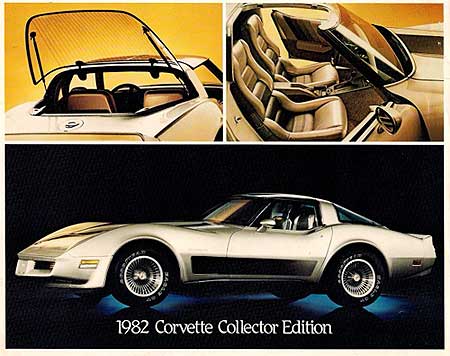Dateline: 9.5.11
Illustrated Corvette Series looks back at the Last of the C3 Corvettes

For the last three months I’ve been having fun with my VETTE Magazine monthly column, “The Illustrated Corvette Series” looking back at what I believe are the “best” of every generation Corvette. So far, we have looked at the ‘62 Fuelie Corvettes and the ‘67 427/435 L89 Big-Block. This month we’re looking at the last of the C3 Corvettes, the ‘82 Collector Edition Hatchback. While it wasn’t the stump-puller from the late ‘60s and early ‘70, the ‘82 Collector Edition was a very sweet machine. So, let’s get straight to it! – Scott
 The ‘70s had been a challenging and strange time for America’s sports car. Performance had been on a decline since ‘70 but because of little to-no-competition, Corvettes sold like hot cakes, hitting an all-time high of 53,807 units in ‘79. Between increasing federal demands for emissions and safety improvements, there was little time for performance. In fact, what should have been a performance improvement through the use of lighter materials – aluminum differential, tube headers, etc – was offset by reduced horsepower due to more stringent emissions controls.
The ‘70s had been a challenging and strange time for America’s sports car. Performance had been on a decline since ‘70 but because of little to-no-competition, Corvettes sold like hot cakes, hitting an all-time high of 53,807 units in ‘79. Between increasing federal demands for emissions and safety improvements, there was little time for performance. In fact, what should have been a performance improvement through the use of lighter materials – aluminum differential, tube headers, etc – was offset by reduced horsepower due to more stringent emissions controls.
When Dave McLellan inherited the Corvette from Zora Arkus-Duntov in ‘75, it was not a pretty picture. Poor quality was rooted in the seriously outdated 1920s St. Louis plant. Rumors of a new assembly plant began in ‘73. Another challenge was the Corvette’s very old chassis and drivetrain. Designed in ‘61, most components were not shared with any other GM car. John DeLorean tried to address this issue with his plan to build Corvettes on the Camaro/Firebird chassis pan. While this might have made GM’s bean counters happy, it would have been a bad move. McLellan was charged with the responsibility of tighter government controls, keeping the Corvette fresh, improving existing hardware, transitioning the car’s assembly plant, and designing and implementing the new C4. A real peach of a job, right?
 Along with the arrival of the new front and rear bumper covers in ‘80 came some serious engine restrictions. In ‘80 the 4-speed manual transmission could not be ordered with the performance 230-HP L-82 engine. For ‘81 there was no performance engine available and California buyers could only get the 180-HP 305 LG4 regular production engine. Then for ‘82, not only was there no performance engine available, but all Corvettes came with the new Turbo Hydramatic 700 R4 4-speed automatic. This was the first time since ‘54 that a Corvette was only available with an automatic. However, it must be pointed out that the ‘82 Corvette engine and transmission was not only an early introduction of the C4’s drive train, but the reintroduction of fuel injection into the Corvette line. Throttle Body Injectors were first introduced in the ‘80 Cadillac Seville. While not the same kind of F.I. last seen on the ‘57 to ‘65 Fuelies, the system was well received and provided drivers with fuelie-like quick throttle response. Another old performance trick was the addition of a solenoid-operated, cold-air hood system that opened up during hard acceleration. The Bowling Green plant came online midway through the ‘81 production and built 8,855 of the 40,606 ‘81 Corvettes. By ‘82 all Corvettes were being built in Bowling Green. This turned out to be one of the best things to happen to Corvettes. The old St. Louis plant was shuttered in the fall of ‘87.
Along with the arrival of the new front and rear bumper covers in ‘80 came some serious engine restrictions. In ‘80 the 4-speed manual transmission could not be ordered with the performance 230-HP L-82 engine. For ‘81 there was no performance engine available and California buyers could only get the 180-HP 305 LG4 regular production engine. Then for ‘82, not only was there no performance engine available, but all Corvettes came with the new Turbo Hydramatic 700 R4 4-speed automatic. This was the first time since ‘54 that a Corvette was only available with an automatic. However, it must be pointed out that the ‘82 Corvette engine and transmission was not only an early introduction of the C4’s drive train, but the reintroduction of fuel injection into the Corvette line. Throttle Body Injectors were first introduced in the ‘80 Cadillac Seville. While not the same kind of F.I. last seen on the ‘57 to ‘65 Fuelies, the system was well received and provided drivers with fuelie-like quick throttle response. Another old performance trick was the addition of a solenoid-operated, cold-air hood system that opened up during hard acceleration. The Bowling Green plant came online midway through the ‘81 production and built 8,855 of the 40,606 ‘81 Corvettes. By ‘82 all Corvettes were being built in Bowling Green. This turned out to be one of the best things to happen to Corvettes. The old St. Louis plant was shuttered in the fall of ‘87.
To send off 15 production years of Mako Shark-styled Corvettes, Chevrolet offered the $22,537 Collector Edition Corvette, the first production Vette costing over 20 grand. This was a sweet package that offered features only available with the Collector Edition , with two totally unique items – the lift-back rear hatch and the C2-like knockoff-style aluminum wheels. The hatch feature should have been introduced back in ‘78 when the fastback rear window first arrived and the 36-fin wheels could have also arrived sooner too. The overall package was a visual delight, with silver-beige paint and black-to-gray hood and side stripes, along with subtle pinstriping. The interior seats, door panels, steering wheel, and horn button were trimmed in exterior-matching silver leather and silver-gray luxury carpeting completed the interior. Unique emblems wrapped up the package.
 Despite the steep for it’s day price of $22,537, 30-percent of the ‘82 production ,6,759 units, were Collector Edition cars. While not the stump pullers from 12 years before, the last of the Shark Corvettes was a refined, polished road machine. For modern retro hot rodders, all an ‘82 Collector Edition needs is a GM crate engine, a modern 6-speed manual transmission, a stout rear differential, and suddenly, it would be 1970 again! – KST
Despite the steep for it’s day price of $22,537, 30-percent of the ‘82 production ,6,759 units, were Collector Edition cars. While not the stump pullers from 12 years before, the last of the Shark Corvettes was a refined, polished road machine. For modern retro hot rodders, all an ‘82 Collector Edition needs is a GM crate engine, a modern 6-speed manual transmission, a stout rear differential, and suddenly, it would be 1970 again! – KST
PS – We have art prints of the above story available HERE.


Here’s the BEST way to keep up with K. Scott Teeters’ Corvette blog!


